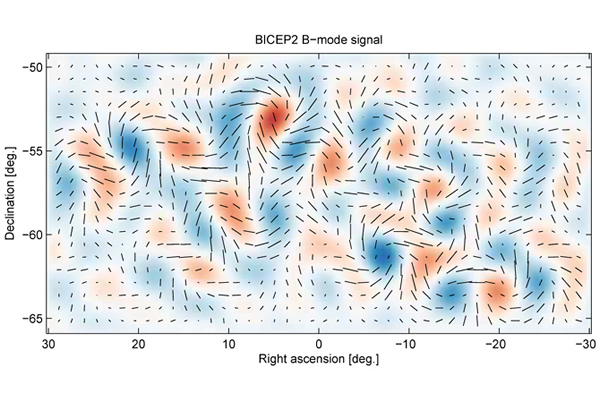Big Bang, Inflation, Gravitational Waves: What It Means
Gravitational waves from inflation generate a faint but distinctive twisting pattern in the polarization of the cosmic microwave background, known as a "curl" or B-mode pattern.
On Monday, astronomers announced a profound discovery. Etched into the most ancient radiation that pervades the entire universe and created — literally — at the dawn of time, gravitational waves have been directly observed, giving us a glimpse as to the nature of the inflationary period that is theorized to have caused the rapid growth of our universe just after the Big Bang.
Finding further observational evidence for cosmic inflation should be discovery enough, but the fact that astronomers now have observational evidence for the existence of gravitational waves makes this St. Patrick’s Day a very special Red Letter Day for Cosmology.
Firstly, what are gravitational waves? These are theorized to be ripples through spacetime and are generated by the motion of anything massive through space. Imagine throwing a ball into a pool — the ripples created will propagate away from the point of impact and bounce around the pool’s surface. Gravitational waves are very similar, but instead of rippling across a ‘surface,’ they propagate at the speed of light through 3-dimensional space. They are theorized to be generated by the collisions of black holes and are thought to have been generated in abundance by the inflationary period just after the Big Bang nearly 13.8 billion years ago.
Einstein’s equations of general relativity predict their existence and there has been some indirect observational evidence of gravitational waves leaching orbital energy from binary star systems. As we are spacetime entities, we should also be able to detect their presence as they pass through local spacetime. Multi-million dollar experiments like Laser Interferometer Gravitational Wave Observatory (LIGO) in Louisiana and Washington have been built to directly detect gravitational waves propagating through Earth. However, their detection has so far proven to be frustratingly illusive.
But in an effort to detect the propagation of gravitational waves at the dawn of time, astronomers using a sophisticated instrument located near the South Pole have detected a very specific signal that betrays the presence of gravitational waves embedded in the ancient cosmic microwave background radiation.
Cosmic microwave background, or CMB, is a well-known artifact of the Big Bang. Considered to be the “echo” of the creation of the Universe, these slight temperature fluctuations observed at the furthest-most edge of the observable universe has been studied extensively by space-borne telescopes such as NASA’s Wilkinson Microwave Anisotropy Probe (WMAP) and Europe’s Planck observatory. These observatories specifically measure the slight temperature perturbations (known as anisotropies) in the CMB to reveal information about the conditions just after the Big Bang and even the age of the Universe.
The rapid inflationary period is theorized to have caused our universe to expand 100 trillion trillion times in a fraction of a second. Fascinatingly, any quantum-sized perturbation that existed at that time will have been rapidly inflated as the universe grew and astronomers have theorized that those tiny structures can be observed today as vast gravitational wave perturbations. But until the use of BICEP2, they thought these waves would be too weak to detect. It turns out that they were wrong.
“This has been like looking for a needle in a haystack, but instead we found a crowbar,” said BICEP2 project collaborator Clem Pryke, of the University of Minnesota.
“The implications for this detection stagger the mind,” said project co-leader Jamie Bock, physicist at Caltech and the Jet Propulsion Laboratory (JPL). “We are measuring a signal that comes from the dawn of time.”
Located in the arid atmospheric conditions of Antarctica, BICEP2 has a very clear view of the cosmos. The instrument has the ability of measuring the polarization of the weak signal from the CMB radiation. On Earth, sunlight can become polarized if it reflects off a mirror or when filtered by polarized sunglasses (thus reducing the glare). The radiation from the ancient CMB can also become polarized and gravitational waves have the ability to manipulate the polarization of the incoming radiation. The specific type of polarization, known as ‘B-mode polarization,’ is what BICEP2 has been looking for. And now, with a high degree of certainty, astronomers have found it.
“The swirly B-mode pattern of polarization is a unique signature of gravitational waves,” said Chao-Lin Kuo, of Stanford University and the SLAC National Accelerator Laboratory, co-leader of the project. “This is the first direct image of gravitational waves across the primordial sky.”
Today’s announcement is being touted as the “discovery of the century,” and although the two papers that were announced today have yet to go to print, the high certainty that backs these results is a huge hint that astronomers may have struck gold. Not only does this finding support the theory of cosmic inflation and the first strong observational evidence of gravitational waves, it could tie in to one of the most perplexing problems in modern quantum physics: What role does gravity play with the quantum world?
Physicists are having a hard time understanding how gravity relates to the Standard Model of physics, a situation that has forced theoretical physicists to pursue increasingly exotic ideas to find an answer. But if today’s announcement is anything to go by, gravitational waves were spawned during the inflationary period, on a quantum scale, meaning there must be some quantum gravity explanation — an explanation that we have yet to comprehend.
“If gravity were not quantized, inflation would not produce gravitational waves,” Alan Guth, of the Massachusetts Institute of Technology (MIT), told New Scientist. “So we really are seeing a direct effect caused by the quantization of gravity, and it is the first time we’ve seen anything like that.”
Source: Caltech, CfA(Mar 17, 2014 01:48 PM ET // by Ian O'Neill)












